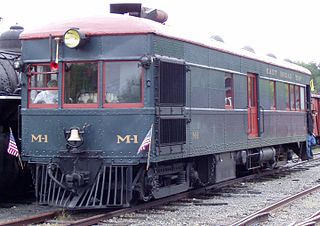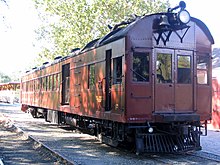On February 8, 1986, in what is now part of Yellowhead County, Alberta, Canada, 23 people were killed in a collision between a Canadian National Railway freight train and a Via Rail passenger train called the Super Continental, including the engine crews of both trains. It was the deadliest rail disaster in Canada since the Dugald accident of 1947, which had 31 fatalities, and was not surpassed until the Lac-Mégantic rail disaster in 2013, which resulted in 47 deaths.

The West Side Line, also called the West Side Freight Line, is a railroad line on the west side of the New York City borough of Manhattan. North of Penn Station, from 34th Street, the line is used by Amtrak passenger service heading north via Albany to Toronto; Montreal; Niagara Falls and Buffalo, New York; Burlington, Vermont; and Chicago. South of Penn Station, a 1.45-mile (2.33 km) elevated section of the line, abandoned since 1980, has been transformed into an elevated park called the High Line. The south section of the park from Gansevoort Street to 20th Street opened in 2009 and the second section up to 30th Street opened in 2011, while the final section to 34th Street opened in 2014.

Doodlebug or hoodlebug is a nickname in the United States for a type of self-propelled railcar most commonly configured to carry both passengers and freight, often dedicated baggage, mail or express, as in a combine. The term has been used interchangeably with jitney. The name is said to have derived from the insect-like appearance of the units, as well as the slow speeds at which they would doddle or "doodle" down the tracks. Early models were usually powered by a gasoline engine, with either a mechanical drive train or a generator providing electricity to traction motors ("gas-electrics"). In later years, it was common for doodlebugs to be repowered with a diesel engine.

The Angola Horror train wreck occurred on December 18, 1867, just after 3 p.m. when the last coach of the Buffalo-bound New York Express of the Lake Shore Railway derailed at a bridge in Angola, New York, United States, slid down into a gorge, and caught fire, killing some 49 people. At the time, it was one of the deadliest train wrecks in American history.

The Corning train wreck was a railway accident that occurred at 5.21 a.m. on July 4, 1912, on the Delaware, Lackawanna and Western Railroad at East Corning freight station in Gibson three miles east of Corning in New York State, leaving 39 dead and 88 injured.
The Cleveland Commercial Railroad (CCR) is a shortline railroad which operates in Cuyahoga County in Ohio in the United States. Founded as a freight-only railroad in 2004, it leases and has trackage rights on lines owned by the Norfolk Southern and the Wheeling and Lake Erie Railway. It also operates an industrial switching railroad at the Port of Cleveland.
The Valley Railway was a shortline railroad which operated between the city of Cleveland and small town of Zoarville in the state of Ohio in the United States. The railroad was founded in 1871, but the first segment of track did not open until 1880 and the line was not completed until 1884. The Baltimore and Ohio Railroad (B&O) obtained a controlling interest in the Valley Railway in 1890. The railroad went bankrupt in 1895, at which time it was reorganized as The Cleveland Terminal and Valley Railroad Company (CT&V). The B&O took over operation of the CT&V in 1909, and the company was merged with the B&O in 1915.
The Lackawanna Limited wreck occurred when a Delaware, Lackawanna and Western Railroad (DL&W) passenger train, the New York-Buffalo Lackawanna Limited with 500 passengers, crashed into a freight train on August 30, 1943, killing 29 people in the small Steuben County community of Wayland in upstate New York, approximately 40 miles (64 km) south of Rochester.

On the night of Wednesday, June 21, 1905, the New York Central Railroad's flagship passenger train, the 20th Century Limited, derailed in Mentor, Ohio, on the Lake Shore and Michigan Southern Railway line, killing 21 passengers and injuring more than 25 others on board. A switch from the mainline to a freight siding was open, causing the Limited to leave the mainline and overrun the siding at high speed. The cause of the accident was never officially determined, but overwhelming evidence points to an act of rail sabotage. The 20th Century Limited connected New York City to Chicago; its running time had just weeks earlier been reduced from 20 hours to 18.







